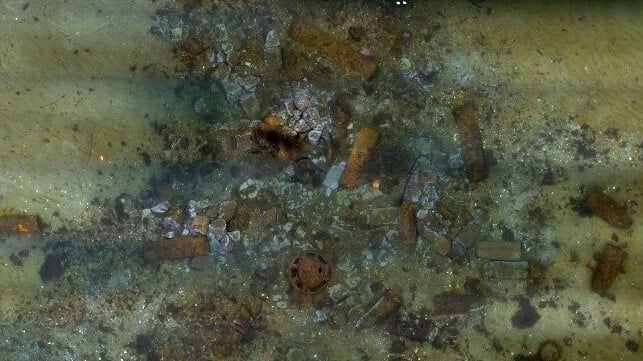German Divers Begin Testing Retrieval System for Seabed Ordnance

Sponsored by a German government environmental program, a Baltic Sea diving and salvage company has begun an extended trial of new techniques to clean up decaying ammunition from the seabed. Germany has a pressing need to solve the problem because the aging munitions in its coastal waters are beginning to leak into the environment, spreading undesirable toxins that could affect fisheries and enter the human food supply chain.
The problem began during World War II, when Germany made explosive devices by the millions. All too many were used, but many more outlasted the German defeat. After the war, Germany was forced to disarm, and an estimated 1.6 million tonnes of its grenades, shells, bombs and rockets were dumped into the waters of the Baltic and the North Sea. This was a rapid and cost-effective disposal method, if lacking in environmental controls, and was widely used by other militaries at the time.
These disposal sites lay dormant for decades, out of sight and out of mind, but are now coming back to haunt German regulators. In the Baltic, where seawater exchange with the open ocean happens only very slowly, concerns about chemical pollution are taken seriously - and these aging explosive devices are now leaking TNT into the water. TNT is considered a possible carcionogen, and animal studies suggest that high levels can cause damage to various organs. In water, it rapidly degrades to trinitrobenzene, an environmentally-persistent compound that can cause liver and nervous system damage in humans. The U.S. NIH classifies trinitrobenzene as "very toxic to aquatic life with long lasting effects."
To reduce the risk, the Federal Ministry for the Environment, Nature Conservation, Nuclear Safety, and Nuclear Safety (BMUKN) is sponsoring research on cleanup methods in the most heavily-contaminated regions. Its "immediate program" has a federal funding budget of about $115 million, aimed at developing a floating munitions recovery and destruction unit that can do the whole process at sea. Waters of the Bay of Lübeck and Bay of Mecklenburg were picked for initial testing because of the high concentration and the variety of old munitions on the seabed in these dump sites.
This week, the Baltic Diving and Recovery Company began a trial-scale project to remove 15 tonnes of aging ordnance from the bottom off the coast of Boltenhagen, about 30 nautical miles to the west of Rostock. Working from a dive support barge, dive teams will work round the clock sorting the munitions under water, loading them into transport crates, and getting them back up to the surface with purpose-built elevators for hoisting, according to local media. Some of the ordnance is highly corroded, and much of it is concentrated in piles on the bottom.
After loading on the barge, the ordnance will be taken back to shore and disposed of. The Boltenhagen trial will cost about $5 million.
"[This trial] is the most ambitious munitions recovery project to date in German marine waters," said Mecklenburg-Western Pomerania's Environment Minister, Dr. Till Backhaus. "We are demonstrating that Mecklenburg-Western Pomerania is taking responsibility – technically, ecologically, and politically."
It is one of several initiatives funded under the program. The German government has also selected Rostock as the home of a new national competence center for munitions recovery, and will be a hub for research on the subject.
